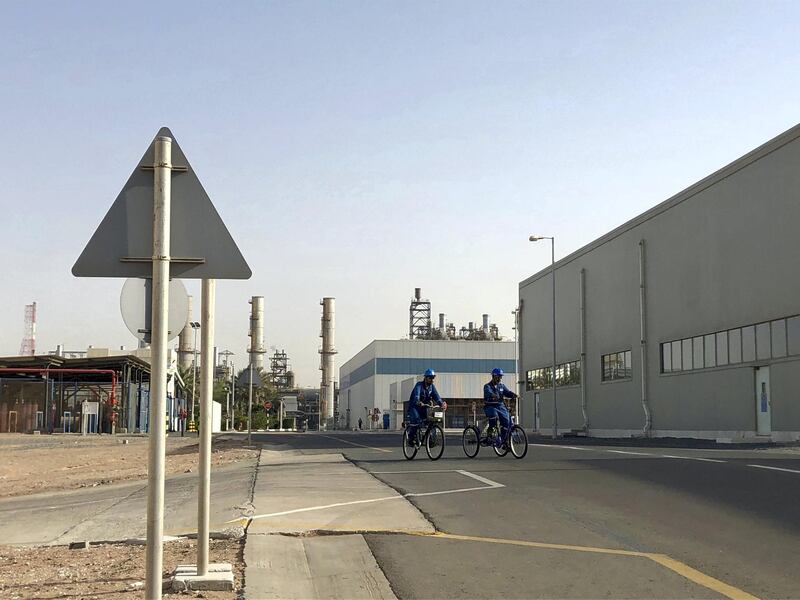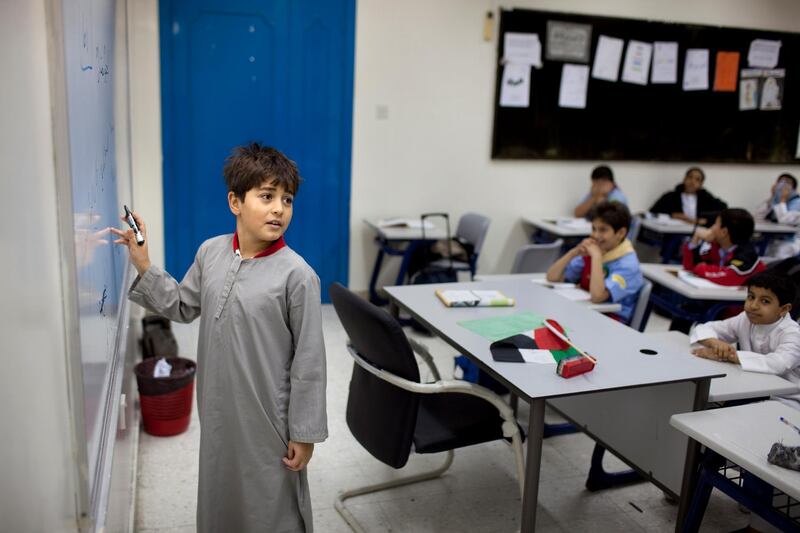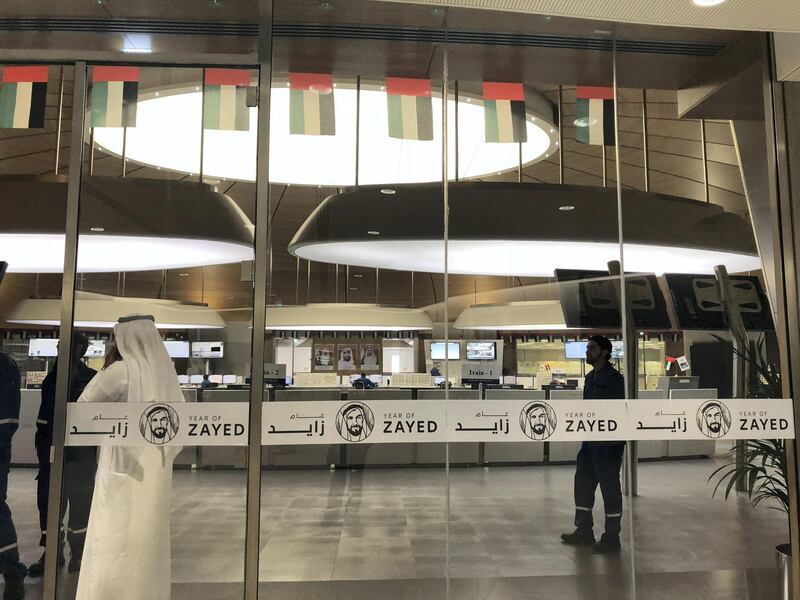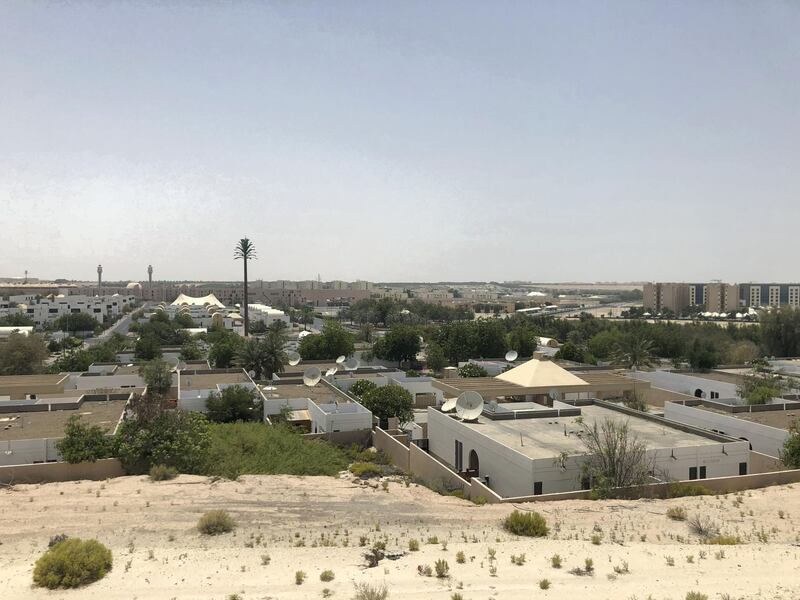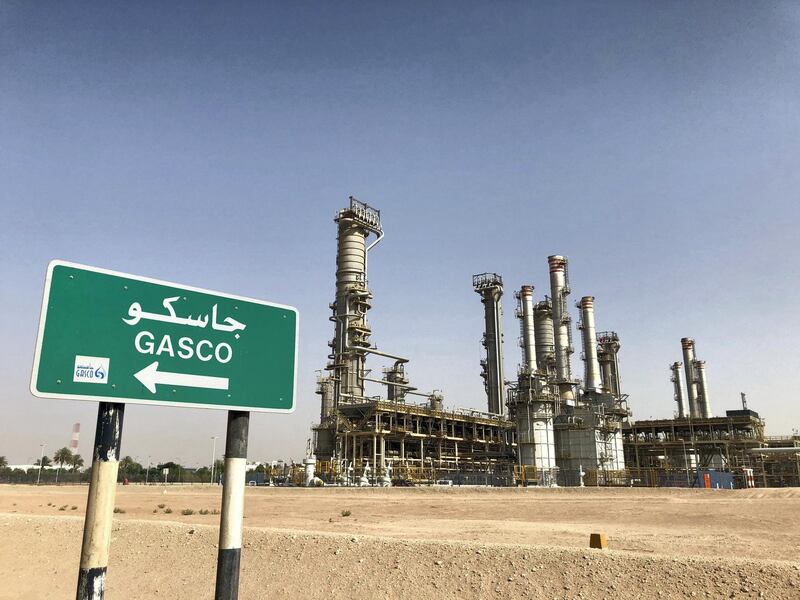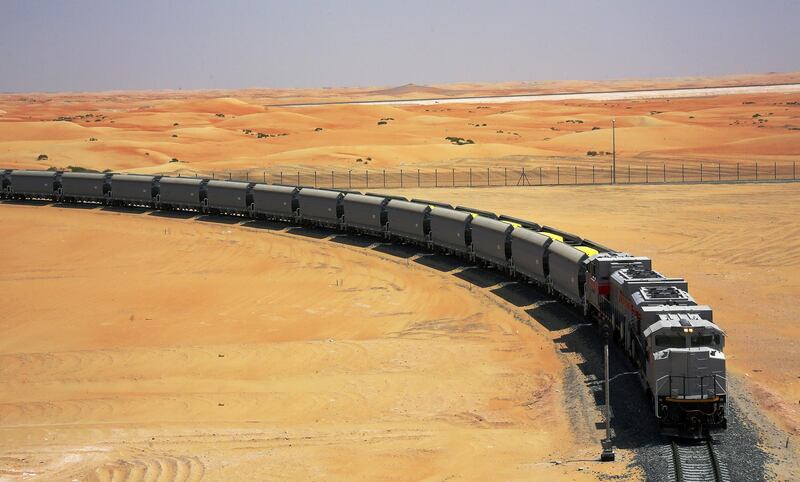“This is Ruwais filter,” our guide Saeed laughed as we snapped pictures on a hillock overlooking a quiet expanse of cityscape that rested under the hazy horizon of Abu Dhabi’s Western Region.
Industrial monuments loom over sandy Arabesque mid-rise compounds and tall steely cylindrical structures frame a landscape that when lit up at night presents a fantastic picture of the epicentre of Abu Dhabi’s hydrocarbons industry in its full glory.
"In the night, we have the best view from here, we call this the Manhattan of Ruwais," said Saeed, an employee of the Abu Dhabi National Oil Company (Adnoc) who was tasked with showing The National around the city, 240 kilometres from the capital and more than four-hours' drive away from Dubai. Growing - almost discreetly - in scale, Ruwais, which sprung up from Abu Dhabi's need to refine the oil spudded out of the ground in the 1970s, spreads across seven square kilometres of dusty hilly outcrop, surrounded all around by sparse hardy desert plant life and little else.
Here, the UAE, which accounts for 6 per cent of global oil production, is developing the world’s largest integrated refining and petrochemicals facility, to meet growing demand globally for fuel and the complex chemicals from which plastics are made.
Adnoc, which produces and sells crude on behalf of the Emirate, will build a new 600,000 barrels per day (bpd) refinery in Ruwais, which is already home to the world’s fourth largest in terms of capacity, at 922,000 bpd.
Once these plans are complete the expanded 1.5 million bpd Ruwais operation will outsize the 1.24 million bpd refinery in Jamnagar in western India, which is now the world’s largest.
The Indian refinery is itself a massive feat of engineering, stretching across an acreage that would cover a third of London, and whose pipes if laid one after another would connect the whole of India from the north to the south.
____________________
Read more:
Adnoc to invest Dh165bn with partners in downstream
Total explores downstream ventures with Adnoc after winning two stakes in offshore fields
Borouge eyes expansion on the back of Adnoc's downstream strategy
Nova Chemicals and Borealis finalise $1.7 billion Texas chemicals joint venture with Total
____________________
Abu Dhabi’s ambitions are truly world-scale and come at a time when refinery towns mean big business in the Middle East. The days of newly nationalised oil companies being content with pumping crude and selling to the oil markets are long gone. Oil companies in the Middle East today are changing their business models to move further down the value chain of the industry.
Apart from being transformed into gasoline that runs automotive engines, oil undergoes further transformation in refineries to yield high-demand products such as jet fuel, diesel, heating oil and naphtha among others. Some of these products are in turn used as raw materials in petrochemicals plants that are now integrated with refining facilities to create highly sophisticated complex products such as different grades of plastics and chemicals that go into a range of everyday products from furniture varnish to laundry detergent. Energy’s transformative effect can be seen in Ruwais itself.
Once a fishing village, the city now has 24,000 people living in the Ruwais Housing Complex built by Adnoc. There are three futuristically modelled sports and recreations facilities, their plastic and steel facades glittering under the sun. Eight schools have opened up offering various curriculums to children of Adnoc employees. The city also has a state university with separate campuses for men and women. Sleek Porsches can be seen parked outside Ruwais’ 261-outlet shopping mall that opened up for residents in 2014, and the city has a hospital now operated by NMC Healthcare.
Urban development in this remote outpost of Abu Dhabi has come amid strategies being pushed by Adnoc to develop the emirate’s refining and chemicals sector, which is collectively referred to as "downstream". Adnoc established itself in the 1970s as a national oil company primarily engaged in exploration and production of oil and gas known as "upstream", across vast areas of Abu Dhabi desert as well as in the waters offshore the emirate. The state company has over the past couple of years set its eyes on becoming an integrated oil company, combining upstream, downstream as well its distribution assets, known in industry jargon as "midstream", under one unified branding last year.
The downstream segment of the energy industry has, however, traditionally had little appeal for international oil companies to get into.
“Historically, the Seven Sisters, the major oil companies didn’t invest in refining, it was all about upstream, getting crude to market,” says Tyler Priest, associate professor of history and geographical and sustainability sciences at the University of Iowa.
When the Seven Sisters, modern day forerunners of BP, Chevron and Exxon, which explored and produced oil in the early part of the 20th century in the Middle East, had to relinquish their investments in the region, following independence and nationalisation movements in the '70s, the newly formed national oil companies decided to take matters into their own hands and invest in refining. However, the integration with chemicals as seen in the facilities being constructed in Ruwais or the multi-billion dollar investments Saudi Aramco is pouring into its western and eastern coasts, are fairly recent innovations.
"The integration of refining and petrochemicals is not something new, it's been there for decades but in the Middle East however, it somehow started in 1985 when Saudi Arabia started to produce aromatics at its Sasref refining complex [in Jubail]," says Iman Nasseri, managing director Middle East, at Facts Global Energy.
“What achieved a step change is the new set of projects being commissioned in this region is that all of them are being designed from scratch as integrated plants,” he says.
The pivot towards building such integrated structures came at a time of large-scale socioeconomic changes sweeping across Asia. The socialist structures that formed the backbone of the populous economies of China and India were undergoing transformation. In the 1980s, China began its shift towards a more capitalist system, industrialising rapidly and spurring the growth of a large consuming middle-class. India on the urging of the IMF in the early '90s began liberalising its economy and opened up to foreign investors. Their middle classes, keen to shake off decades of socialist austerity, demanded more choice in goods and services. The newly nationalised oil companies of the Middle East now found an opportunity to sell more than just barrels of oil to large scale refineries in these economies. They could actually become the manufacturers of products.
“It made more sense because they cut down logistics and planning and as the owner of the two parts of the business; they tried to optimise [refining and chemicals] by placing them next to each other and creating synergies in terms of operations and other costs,” says Mr Nasseri.
On May 13, in Abu Dhabi, Adnoc’s group chief executive Dr Sultan Al Jaber revealed the company's plans to invest $45bn in the downstream sector in partnership with global oil and gas players to transform Ruwais to become a world leader in the industry. This will translate into creation of 15,000 jobs and a GDP growth of one per cent annually to the UAE's economy leading up to the completion of the facilities in 2025. A new derivatives and conversion park that will add to manufacturing capabilities at Ruwais as well as the formation of industry clusters are set to broaden the country's economic base beyond just direct oil revenues and the transfer intellectual and technological talent and capital to the UAE.
Those studying opportunities to set up base in Ruwais and in attendance at Adnoc's first ever downstream investment conference included existing partners in the upstream business such as France's Total, Italy's Eni, the US' Occidental, Indian Oil Corporation and China National Petroleum Corporation among others.
Delighted to host @OXY_Petroleum President and CEO, Vicki Hollub, who will share her views at the #ADNOC Downstream Investment Forum. For more information, visit:https://t.co/PKEqP3QHZQ pic.twitter.com/c5vUKv3Sec
— ADNOC Group (@AdnocGroup) May 11, 2018
New facilities under development in Ruwais and in Saudi Arabia, which plans to build the world's largest oil to chemicals plant on its west coast by 2025, cater to specific kinds of products called middle distillates, which go into the making of fuel used by the aviation industry. A driver for this development is a highly mobile middle-class in Asia, which looks to increasingly connect with the global economy, driving the growing demand for jet fuel in the region.
Ruwais and the development of its chemicals facilities finds resonance across the region, where countries are looking to spur growth in remote locations, often with access to ports and cities into multibillion-dollar investment landscapes.
Refinery towns have become the new champions of economic development in petro-economies of the Middle East looking to slowly wean themselves away from their reliance on the sale of barrels of oil.
Oman, one of the smaller producers of oil in the region is currently undertaking development of Duqm, a sleepy town famed for its camel jockeys, by building a 230,000 bpd refinery in partnership with the international arm of Kuwait’s oil company. The planned refinery, which is currently under development will also look to have an integrated chemicals complex, providing jobs and opportunities for residents of the small town.
These multi-billion dollar developments in the Middle East hark back to far simpler and entrepreneurial times of the early oil industry in the United States, where massive economic development boomed around nondescript little towns where oil spurted from the ground.
“In the 1920s and 1930s, oil in America was being drilled in some of the poorest regions of the country so to get a job with a company that had a town was a dream for many Americans and they included amenities of basic services, water, electricity and also social amenities, community halls, churches, recreational sites,” says Darren Dochuk, associate professor, department of history at the University of Notre Dame.
“So for the first half of the 20th century, you had these community towns that were prospering in quite dramatic ways, meanwhile in kind of larger refining centres, for instance in the southern part of Texas along the Gulf, you were getting that same effect but on a larger scale and on a more permanent scale. Typically, towns growing into cities rapidly tend to be more diverse in terms of their racial, ethnic composition but again very clear loyalties to the companies,” he added.
In Ruwais, far removed from the main centres of commerce and politics in the UAE, a quiet ecosystem thrives. Unlike Aramco’s Dhahran in the kingdom’s eastern province, which replicated an American suburban neighbourhood in form and function, Ruwais is quintessentially Arab. Saeed guides us through old residential units, with curved roofs that have developed on sloping land that reminds one of Amman’s hilly streets.
“They’ve been here since the '80s,” he said. We turn a corner and see dune-coloured buildings under construction. They’re for bachelors living in Ruwais City, he informs us.
The city is expected to have up to 10,000 residential units from 7,500 at present to house a population that’s expected to surge with the planned expansion of its industrial facilities.
Saeed himself lived in one such bachelor accommodation but moved out because the American-style open kitchen wasn’t to his taste and he needed somewhere closed to cook.
We pass by I Love Burgers, a popular Dubai fast food outlet that has opened up in Ruwais. Adjacent to that is Mira’s Creamery, with advertising announcing “ice cream, love and more”.
Saeed is amused. “We have all this but our best kept secret is the butcher.”
He shows us Ruwais’ slaughter house.
“He’s the best in Abu Dhabi, wallah,” he laughs.
We go back to the hillock from where Saeed watches Ruwais’ fully lit industrial sites at night and he recounts the hospitality of the city’s Bedouin inhabitants.
“There is dhabiha for everything,” he says, using a local term for a feast involving slaughtered lamb or camel, usually in honour of a guest.
“If someone gets a promotion, there’s dhabiha, a TV, there’s dhabiha, if they’re happy, there’s dhabiha and they invite us all. Life is good, Alhamdulillah.”

